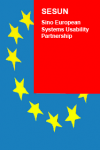Chinese-European collaboration on HCI, usability and user-centred design
In addition to large-scale information systems, SESUN addresses mobile applications, consumer products and personal and ubiquitous technologies.
Europe is a leading contributor to the underpinning field of Human-Computer Interaction (HCI) but this is not currently afforded the same priority in China. By building upon both the EU Framework V funded ‘UsabilityNet’ project and the Asia IT&C co-financed Indo European Systems Usability Partnership, SESUN will develop active and sustainable links between the Chinese and European IT communities, promoting HCI/usability within China and facilitating the design of a new generation of ITC systems for a global community.
Activities include seminars and research workshops in China, implementation studies and virtual communities.
SESUN is organised by a Steering Group comprising the main partners of the project. The national body involved is the British Computer Society / British HCI Group. The other partners are Thames Valley University (UK), Dalian Maritime University (China), the University of Limerick (Ireland), Uppsala University (Sweden), University of Kaiserslautern (Germany), and CURE (Austria).
The initiative seeks to address four main themes: integrating HCI in the university curriculum, user-centred design, interaction design, and culture and localisation.
Rachel Jones from Instrata reports on the user-centred design (UCD) workshop tour of China, that she participated in, with workshops in Beijing, Dalian and Shanghai.




